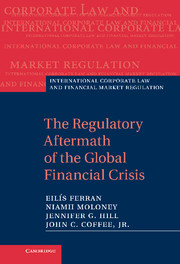Book contents
- Frontmatter
- Contents
- Foreword
- Notes on Contributors
- Acknowledgements
- Table of cases
- Table of legislation
- 1 Crisis-driven regulatory reform: where in the world is the EU going?*
- 2 The legacy effects of the financial crisis on regulatory design in the EU
- 3 Why did Australia fare so well in the global financial crisis?
- 4 The political economy of Dodd-Frank: Why financial reform tends to be frustrated and systemic risk perpetuated
- Index
- References
3 - Why did Australia fare so well in the global financial crisis?
Published online by Cambridge University Press: 05 December 2012
- Frontmatter
- Contents
- Foreword
- Notes on Contributors
- Acknowledgements
- Table of cases
- Table of legislation
- 1 Crisis-driven regulatory reform: where in the world is the EU going?*
- 2 The legacy effects of the financial crisis on regulatory design in the EU
- 3 Why did Australia fare so well in the global financial crisis?
- 4 The political economy of Dodd-Frank: Why financial reform tends to be frustrated and systemic risk perpetuated
- Index
- References
Summary
Introduction
The history of corporate governance is also a history of crises and scandals.
Klaus J. HoptAustralia provides an intriguing case study in relation to the global financial crisis. At first sight, at least, Australia appears to have withstood the crisis remarkably well, living up to its famous description as “the lucky country.” This has been the source of numerous laudatory statements by government officials and others throughout the global financial crisis. In 2008, the Governor of Reserve Bank of Australia commented, for example, that “there would be very few countries, if any, which would not envy Australia's fiscal position.”
Although the impact of the financial crisis has been less severe in Australia than in many other jurisdictions, including common law jurisdictions such as the United Kingdom and the United States, it cannot be said that Australia escaped the crisis unscathed. There were, for example, a number of high-profile corporate collapses. Also, more recently, messages concerning the state of the Australian economy have become decidedly mixed. There is a growing perception that economic performance is uneven, and that there exists a widening “two speed” or “multi-speed” economy, where “not everybody. . . is in the fast lane.” This refers to the fact that, in contrast to Australia’s booming resources sector, large segments of the economy have experienced weak consumer spending in recent times.
- Type
- Chapter
- Information
- The Regulatory Aftermath of the Global Financial Crisis , pp. 203 - 300Publisher: Cambridge University PressPrint publication year: 2012
References
- 16
- Cited by



